


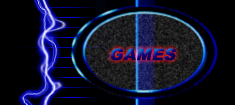
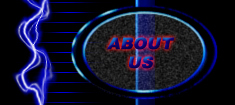

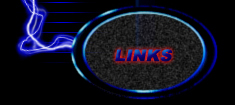

by Logan Everett (E-mail Me)
#7 - Preliminary Game Concept
Title: Circuit Breaker
Genre: Strategy/Puzzle
Platform: Windows 95/98
Development: Visual Basic 6.0
Basic Concept: To control every "socket" on a tiled board by moving pieces across wires to erase enemy pieces. This game is similar to Checkers or Othello.
 In-depth
Description: Circuit Breaker is played on a 12x12 (just an approximation)
board of tiles. Each tile can be a socket or part of a path of wires.
Each socket has four sides and can therefore be connected to a maximum
of four wires (and a minimum of one). Wires can cross over one another,
but may not split. Therefore each socket can only connect to a maximum
of four other sockets.
In-depth
Description: Circuit Breaker is played on a 12x12 (just an approximation)
board of tiles. Each tile can be a socket or part of a path of wires.
Each socket has four sides and can therefore be connected to a maximum
of four wires (and a minimum of one). Wires can cross over one another,
but may not split. Therefore each socket can only connect to a maximum
of four other sockets.
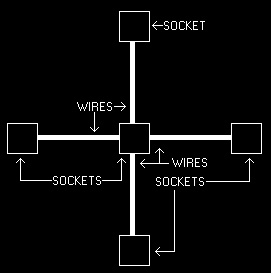 Two players
(one can be computer controlled) take turns. Each turn, the player can
either place a piece on an empty socket, or "activate" the piece. When
a piece is activated it spreads across all wires connected to that socket.
If it hits an empty socket then a new piece is placed there. The original
piece is left in the starting socket as well. I have developed two separate
methods for "erasing" enemy pieces.
Two players
(one can be computer controlled) take turns. Each turn, the player can
either place a piece on an empty socket, or "activate" the piece. When
a piece is activated it spreads across all wires connected to that socket.
If it hits an empty socket then a new piece is placed there. The original
piece is left in the starting socket as well. I have developed two separate
methods for "erasing" enemy pieces.
The High and Low model: Each time a player decides to place a piece, they put a "low charge" of their color on the socket. If a low charge spreads to an empty socket it creates another low charge. If it spreads to a socket controlled by the same player that also has a low charge, it creates a high charge. Charges that spread to a socket controlled by an opposing player can erase as follows: A low charge can erase another low charge, but cannot erase an opposing high charge. A high charge can erase any opposing charge. A high charge can not be enhanced any more by incoming charges from the same player. A high charge can only spread a low charge to empty sockets.



First the player places a Low Charge. On the second turn they spread
it to the adjacent socket. On the third turn it spreads again and the
low charge becomes a high charge.
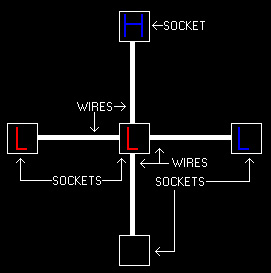
Example: The Red player had the advantage of the middle socket.
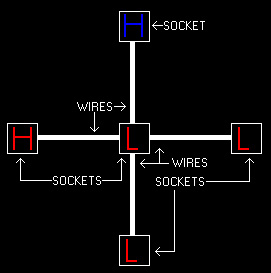
Red Turn 1: The Red player spreads to all sockets except the top, because
a low charge can't erase a high charge.
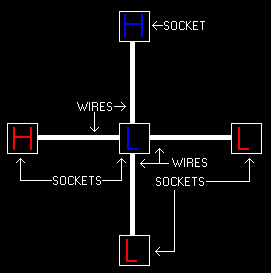
Blue Turn 1: The Blue player activates the High charge which spreads
and erases the low charge.
 The
Plus and Minus model: Each time a player places a piece they choose between
a "positive charge" represented by a plus, or a "negative charge" represented
by a minus. Charges could erase as follows: A positive charge can erase
an opposing negative charge, but not an opposing positive charge. A negative
charge can erase an opposing positive charge, but not an opposing negative
charge. If a charge spreads to a socket you already control, then there
is no change. However, you can place pieces on sockets you already control
(as opposed to empty sockets) in order to change the type of charge.
The
Plus and Minus model: Each time a player places a piece they choose between
a "positive charge" represented by a plus, or a "negative charge" represented
by a minus. Charges could erase as follows: A positive charge can erase
an opposing negative charge, but not an opposing positive charge. A negative
charge can erase an opposing positive charge, but not an opposing negative
charge. If a charge spreads to a socket you already control, then there
is no change. However, you can place pieces on sockets you already control
(as opposed to empty sockets) in order to change the type of charge.
Both methods are simple and strategic. In both cases, the player starts off controlling no sockets, and wins when they control all sockets. Here are some other concepts that could add new elements of strategy to the game:
- Colored Sockets: Players can only place new charges on sockets that match their color, and must gain control of all other sockets by spreading across wires.
- Multiple Boards: A variation of boards, and a board editor would allow for endless new strategies.
- Multi-Player: Three or four player boards would be even more interesting!
I may develop this game in the near future, if you would like to borrow any of my ideas, just E-mail me.
Page Updated: 4/13/00
